Highlights of the Amsterdam Pipe Museum
Author:
Don Duco
Original Title:
Hoogtepunten uit het Amsterdam Pipe Museum
Publication Year:
2020
Publisher:
Amsterdam Pipe Museum (Stichting Pijpenkabinet)
A pipe like a crumhorn
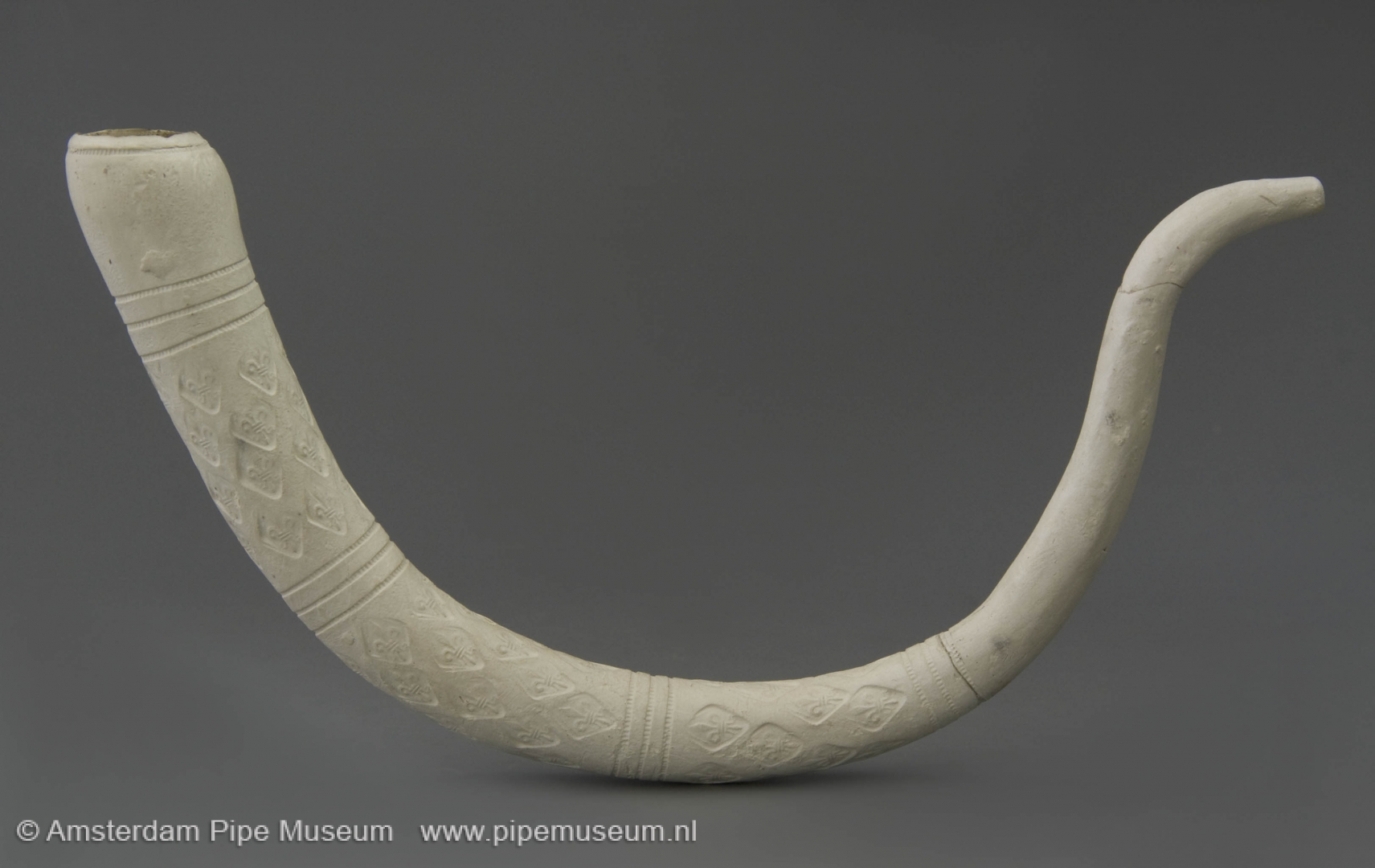
The Dutch clay pipe is a typical serial article. It is made in large numbers in a press mould and is therefore consistent in shape. Only during the finishing additional actions can be taken to increase the quality. Only in rare cases the pipe maker feels the desire to come up with something original and therefore interrupts the serial production. Then he takes a piece of pipe clay to create a special object, with or without preformed parts from a mould. An example of this is the pipe shown here in the form of a crumhorn.
Although this pipe is largely made by hand, it is really a product from a regular pipe makers’ workshop. The bowl was pressed in a standard two-piece press mould that was only available to the pipe maker. Subsequently, a much thicker stem was made on this pipe bowl, which was connected to the largest diameter of the pipe bowl, strongly tapering towards the end. This probably happened on the wire, the pin that was normally used to make the smoke tube. After the surface was smoothed and the iron wire removed, the clay roll was bent in a large upward curve with a counter twist at the mouthpiece. The stem is finished with a stamped decoration, consisting of three batches of lilies in diamonds, each group separated by three concentric rings of millings.
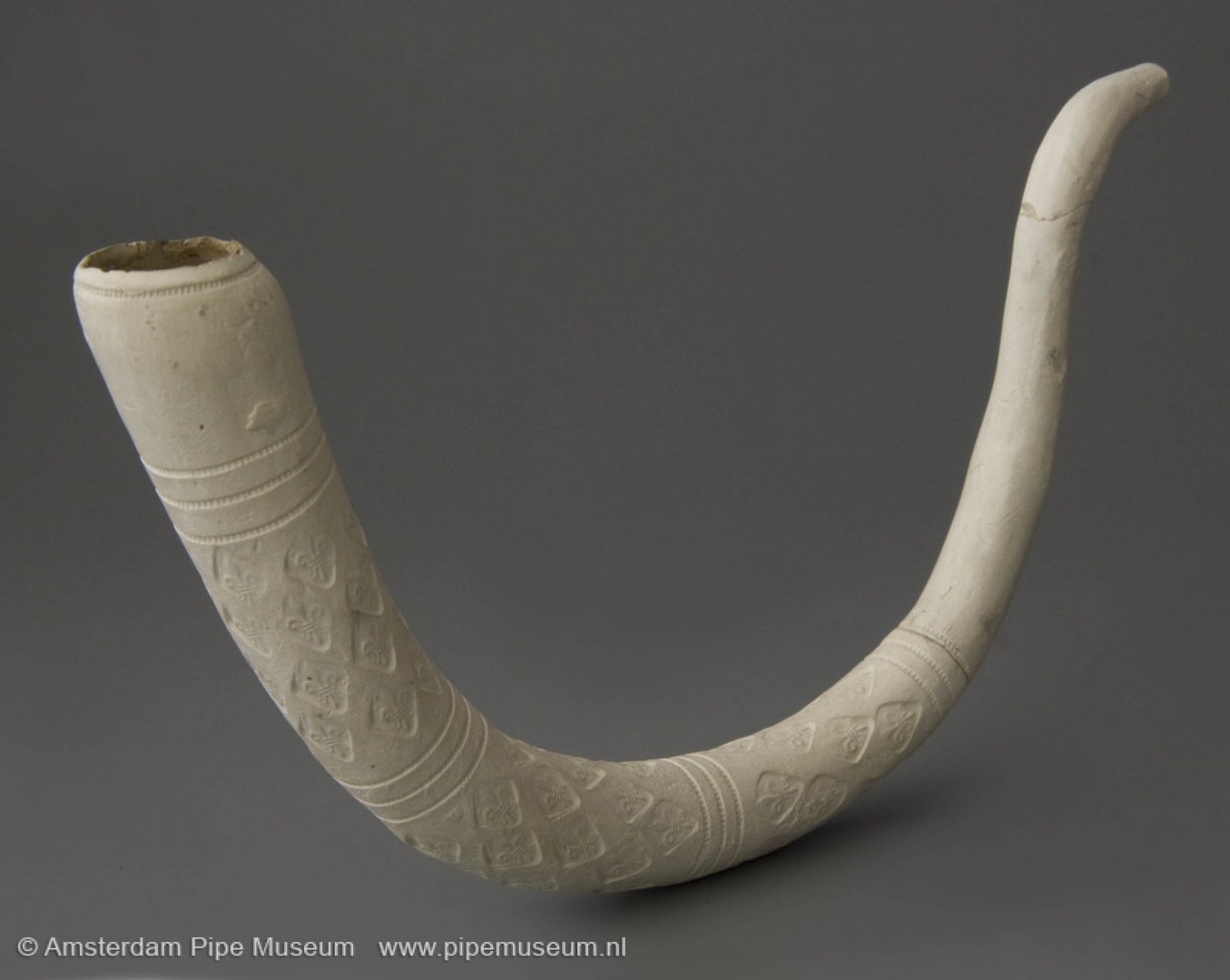
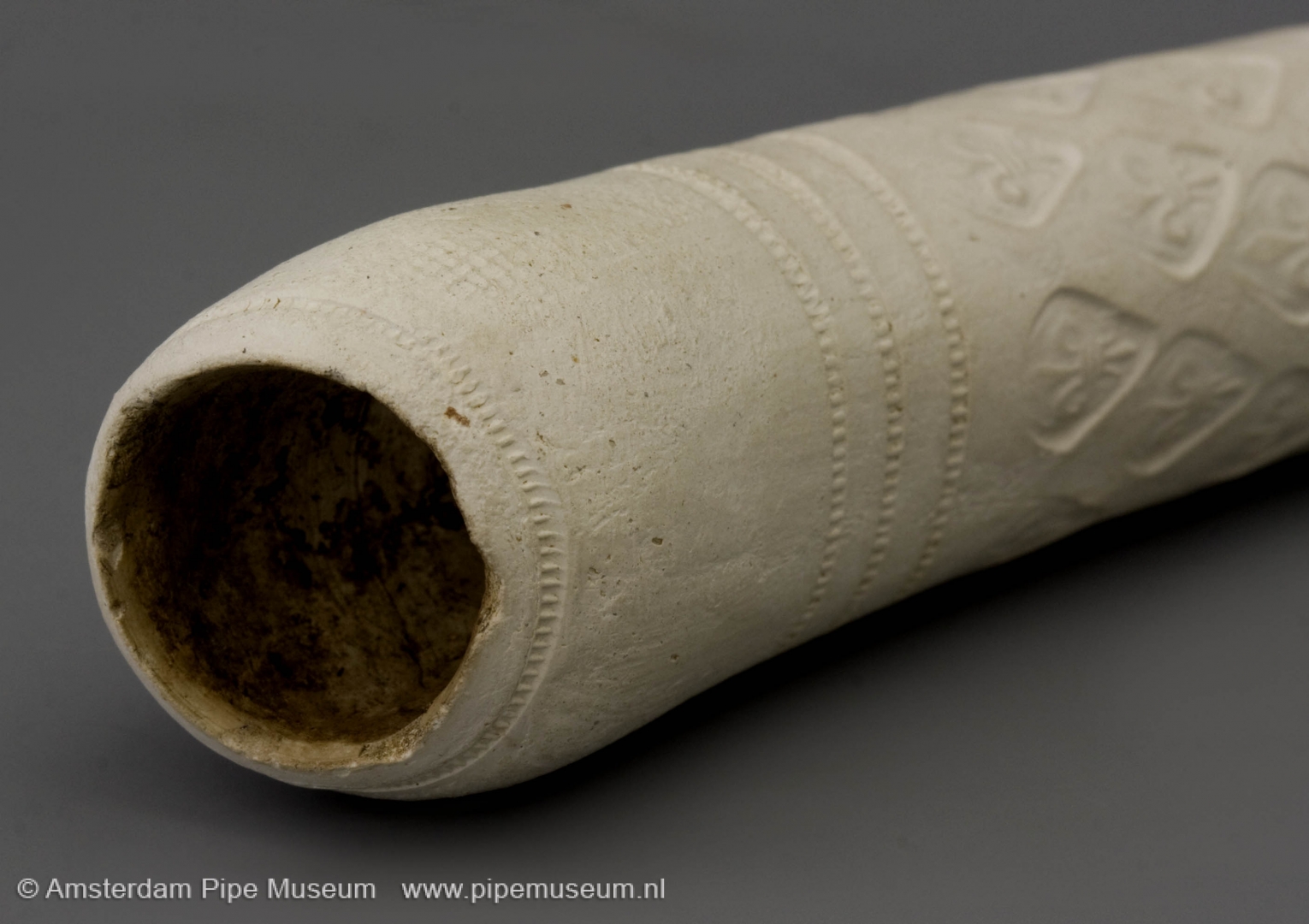
Such pipes can be made anywhere in the Netherlands, although the tools point to manufacture in the city of Gouda. Firstly, the press mould used has the so-called dikkop size, a pipe shape that was launched in Gouda in the 1640s and has only been popular for a short time. In addition, the use of a specific milling stamp and the stamp to make the diamond shape filled with a lily are characteristics for the Gouda pipes. This version of the lily motif is in Gouda in use between 1645 and 1650, after which it changes its size and appearance. The date of the stamp corresponds to the production period of the press mould used.
You would expect that such a hand-modelled pipe is unique, but that does not seem to be the case. More often fragments of such pipes were found, but because they were small pieces, we remained uncertain about the shape of the complete pipe. This discovery from the city centre of Leiden means that we now know what a complete pipe has looked like. The way of making indicates that it cannot be unique but a product made in a small series. The method of manufacture is too perfect and above all too sophisticated to be a piece on its own. Although the bent horn as a pipe has been a temporary phenomenon and only became known among a small group of smokers, the spread is still wider than one would expect. Most surprising, however, is that fragments have been excavated in Virginia from a nearly identical curved horn pipe, made locally but unmistakably with an example of such a Gouda specimen.
Literature: Don Duco, Gedachten rond een raadselachtig vondstcomplex, Amsterdam, 1995.
Amsterdam Pipe Museum APM 9.601
An exotic from the polder
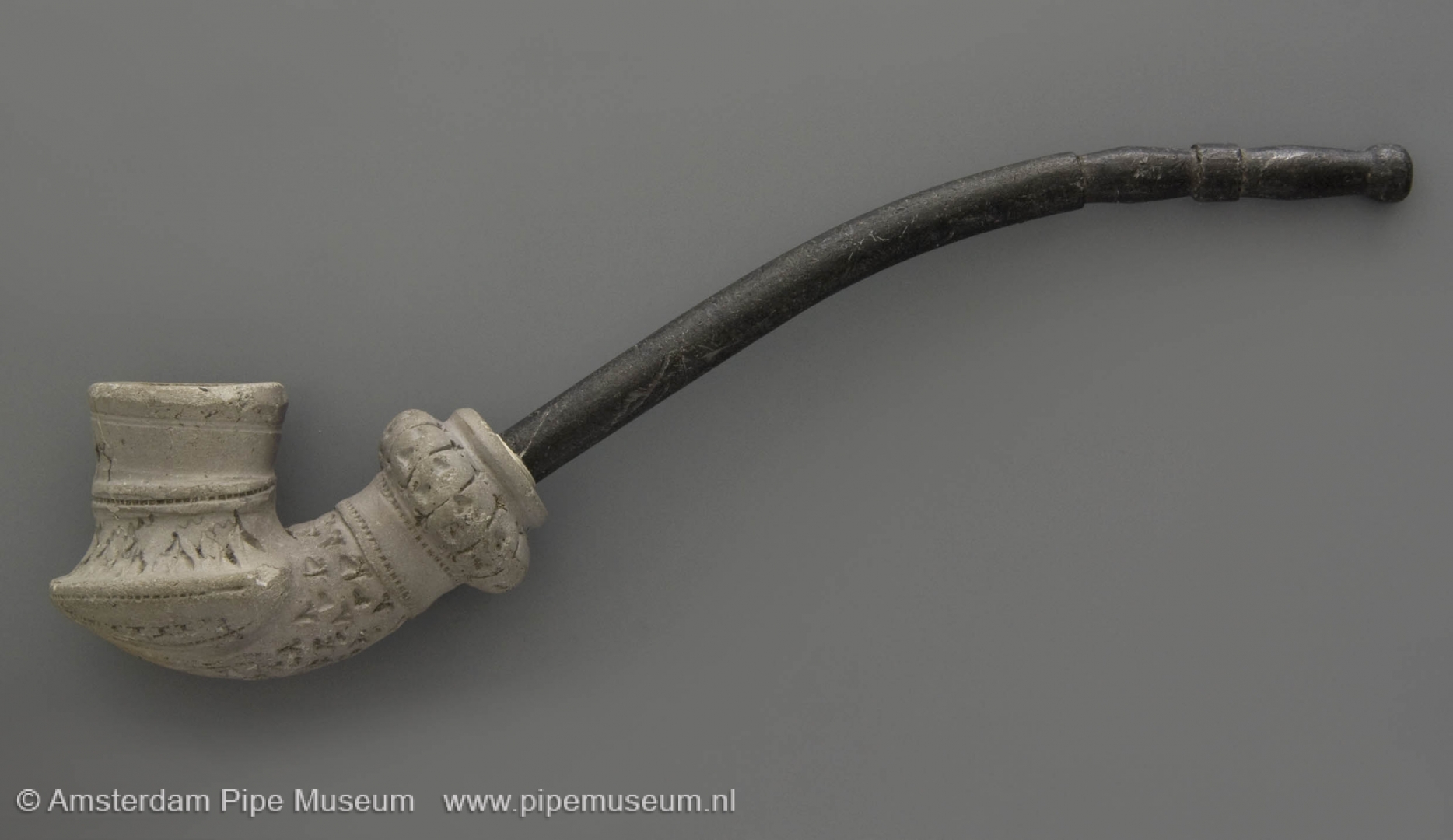
Most of the pipes found in the soil are ordinary, common pipes, sold by the thousands, generally smoked and then thrown away. It is only rarely that an alternative smoking instrument is found, coming from a smoker who liked to show off with something special. Such a remarkable discovery was made in 2001 in Schermerhorn near Alkmaar. From a ditch fill an exotic pipe emerged, which apparently came to the province of North Holland as a souvenir.
It is a so-called stub stemmed pipe, a pipe with a truncated stem to which a separate stem was attached. The pipe bowl is made of a relatively soft baked light grey clay. As a result, the pipe guarantees an optimal absorption of the tar and nicotine juices released during smoking, resulting in dry and therefore tasteful smoking. For the Dutch smoker the bowl is generous in size, the local pipes were certainly three times smaller. This pipe bowl has a cylindrical shape with a slight widening at the opening. A dish-shaped bulging has been made at the base, which turns into a semi-circular underside. A kind of rat tail is visible as marking of the underside and as a prelude to the stem. The pipe is provided with a rising stem that is reinforced with a cuff band with a semi-circular profile. Although the stem ends with a cuff, it still runs through the same diameter. All these characteristics indicate an origin in the Ottoman Empire.
Completely opposite to the Dutch clay pipe, this product is not pressed in a two-part mould but is made on a potter’s wheel. Bowl and stem are turned separately and then glued together with some moist clay, the so-called rat tail functions as reinforcement. Then the seams were carefully smoothed out. Finally, a decoration was stamped that made the last traces of gluing the two parts invisible. During the stamping of the decoration, a repetitive pattern was created, separated by ropes and chain lines. How seriously this decorating was executed is proven by the fact that 120 individual imprints have been made. It is striking that the four different stamps that were used side by side differ so little in detail that the effect with one and the same stamp was hardly any less.
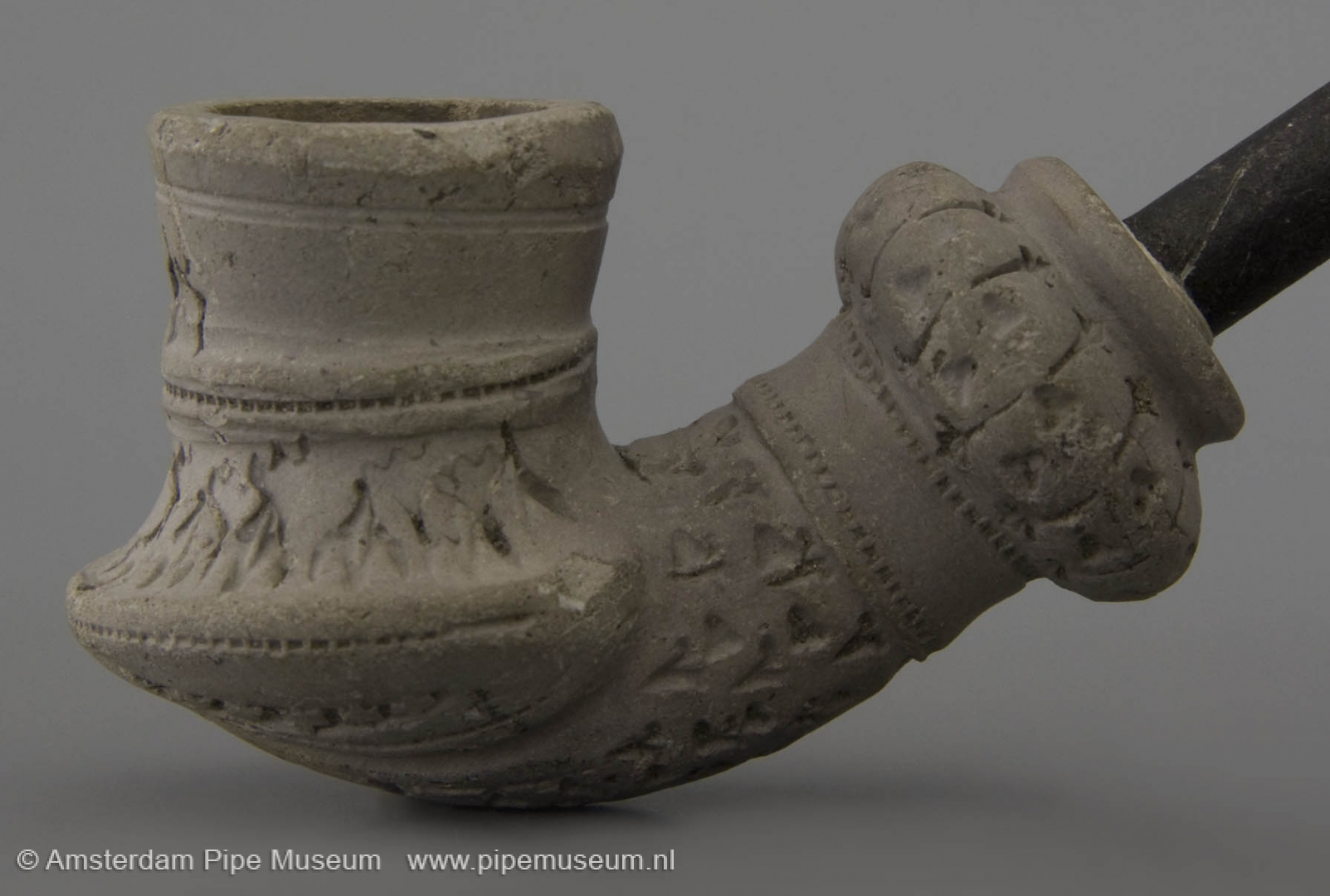
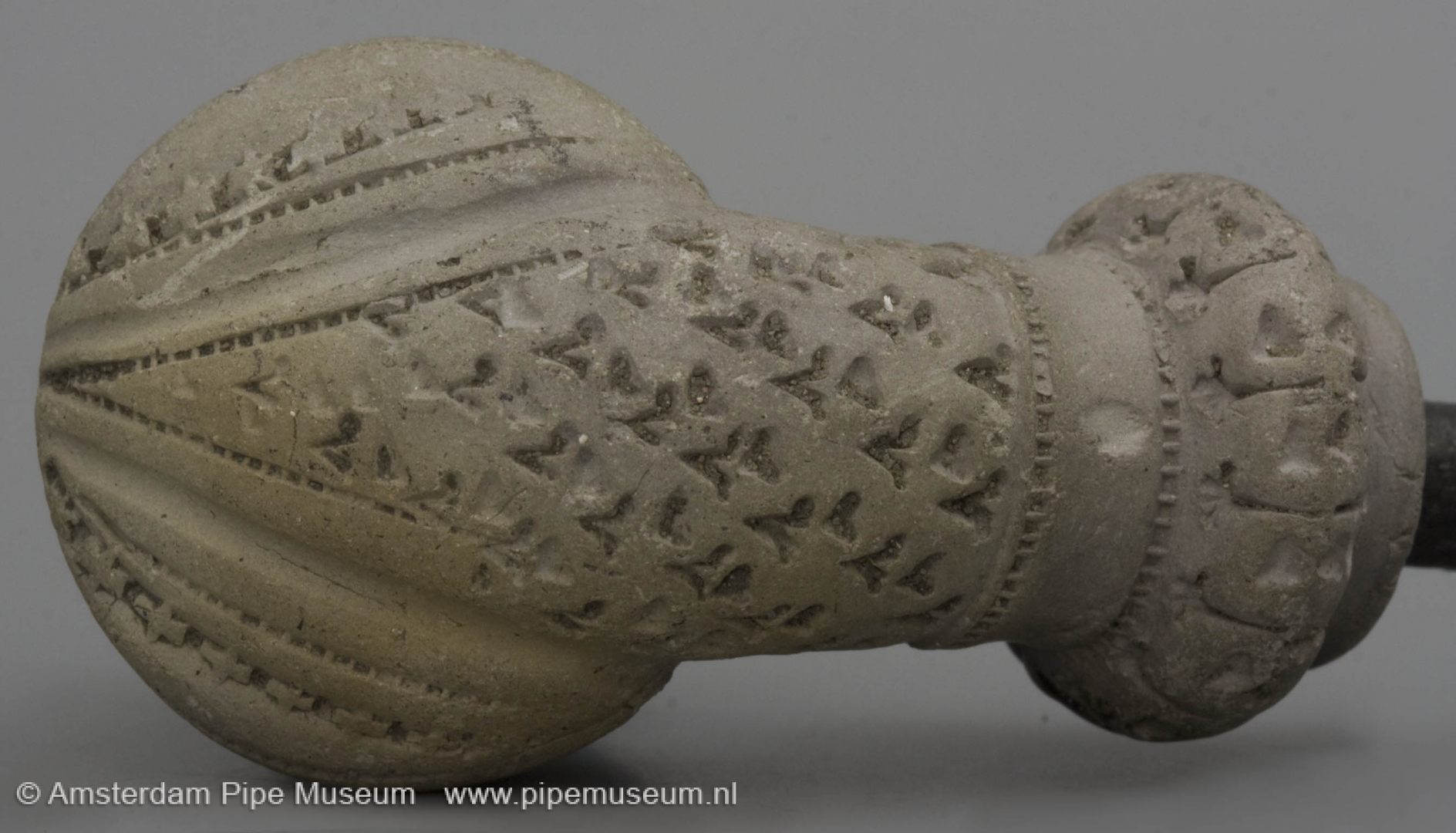
In addition to the fact that the pipe bowl still is in perfect condition, it is unique to this find that the original stem was also found. Against everyone's expectations, it is not a stem made of reed, wood or bone, but in lead. This might be a local replacement for a previous one that was blocked or broken. Especially the stem end is remarkable: this is cut out so that it gives the impression of being copied from the original stem end made on a lathe. By the way, lead is not a very suitable material for a pipe stem, it gives off taste and does not absorb moisture. Fortunately, the latter, negative factor is more than compensated by the porous bowl, so that the pipe will still have smoked pleasantly.
The fact that such an exotic pipe was found in the rural Schermerhorn is unexpected but not completely strange. The population lived there from fishing and shipping. It is possible that one of them signed on a ship heading for the Strait of Gibraltar and ended up in the eastern Mediterranean. So this pipe made at a distance of at least two thousand kilometres can end up as a travel souvenir in Schermerhorn. In view of the finding conditions, this must have been between 1665 and 1685. At home, the smoker was in any case assured of all attention for his exotic smoking equipment.
Literature: Don Duco, Een exotische pijp uit Schermerhorn (An exotic pipe from Schermerhorn), Amsterdam, 2003.
Amsterdam Pipe Museum APM 16.824
A regal portrait pipe

We can safely say that this great large-size clay pipe is the most exceptional pipe find from the Dutch soil. This pipe with an attractive and artistic depiction was found near Nijenrode Castle in the facing of the river Vecht, to be precise in November 1986. Initially, the find in the muddy clay was mistaken for a decorated handle for a jug or pitcher. It was not until a day later, while cleaning, that the finder discovered what it was all about. A unique pipe due to its large size, with a figural design that was unknown until then, but so special because the object is in perfect condition.
The making of an exceptional piece is a habit of all time, as an artistic achievement or remarkable creation distinct from the standard article. A special feature of this archaeological find is the high quality of the depiction, the pipe has been worked out as a true sculpture and has thus acquired artistic allure. On the front of the bowl we see the crowned portrait of a regal person. On either side of the bowl, the face is flanked by a long curly wig that extends to the stem. Below the chin the royal person wears a lace cravat, closer to the stem end we see the smooth shield for a coat of arms.
The design shows a clear visible side in the facing portrait. This characteristic two-dimensionality may be due to the use of a print as an example. That print has led the maker to lose sight of three-dimensionality. The back of the object is left undecorated with the outline of a standard pipe bowl with heel, only much larger. Careful examination proves that it was not a one-off object, but that the pipe was printed in a two-part mould. Not in the usual way, but with the mould seams on both sides of the pipe. The representation from the top half of the mold was later carefully hand modeled, the bottom part has been left untouched.
A piercing at the heel gives the impression that the pipe was intended for hanging. If you hang it high, the portrait will look at you more paternally. We often see that hanging hole with such large-size pipes. Another reading is that it is a locking eye that serves to safely secure the pipe bowl to a stem made of a different material. In this way the pipe could actually be smoked or carried in a festive procession.
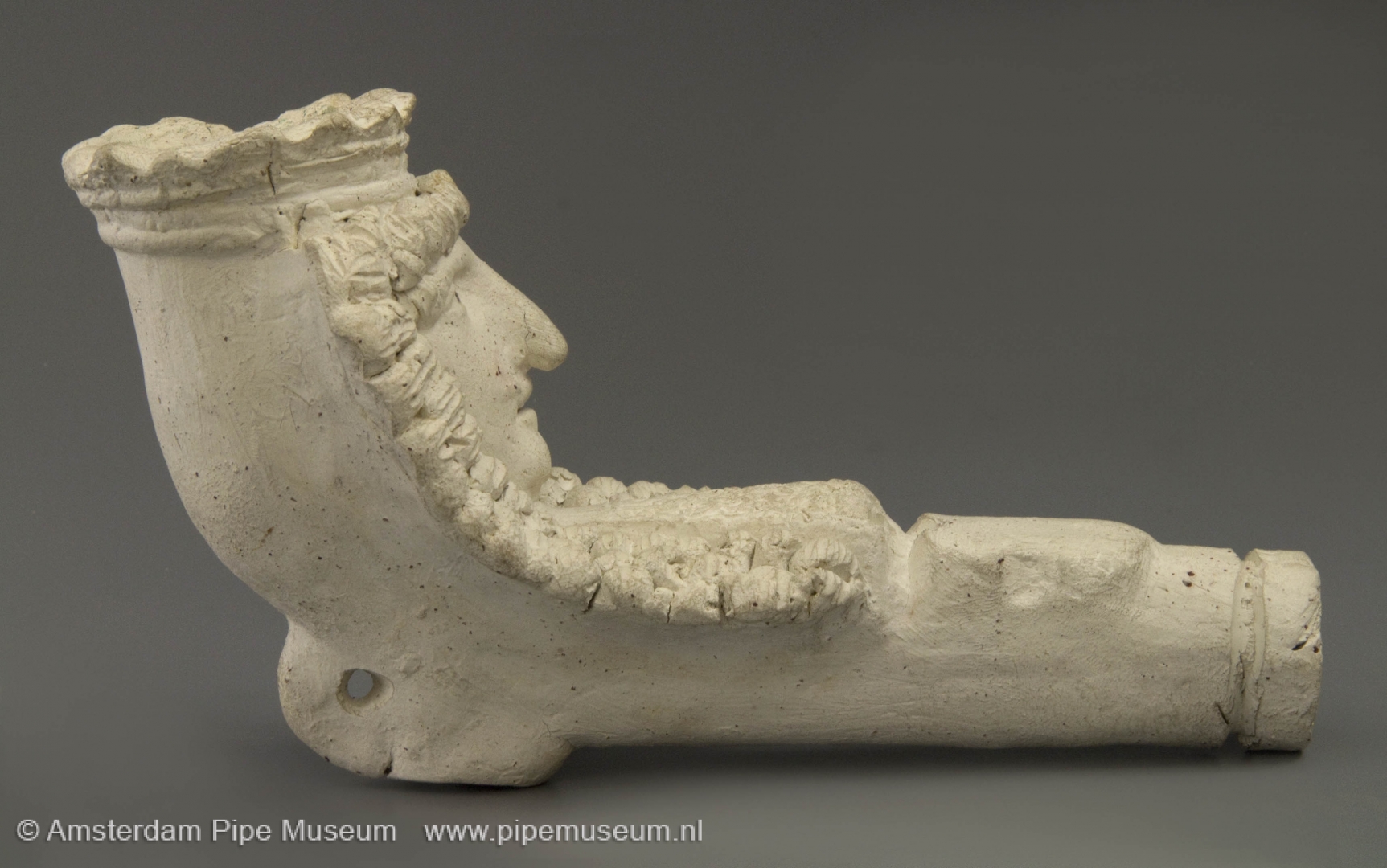
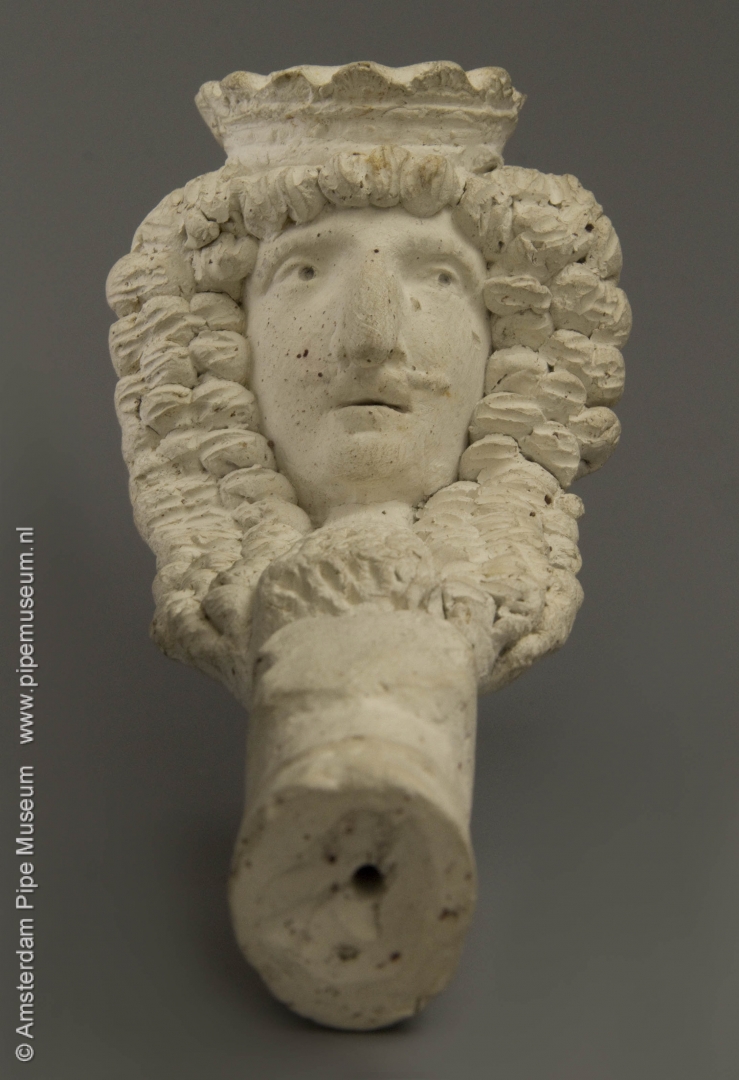
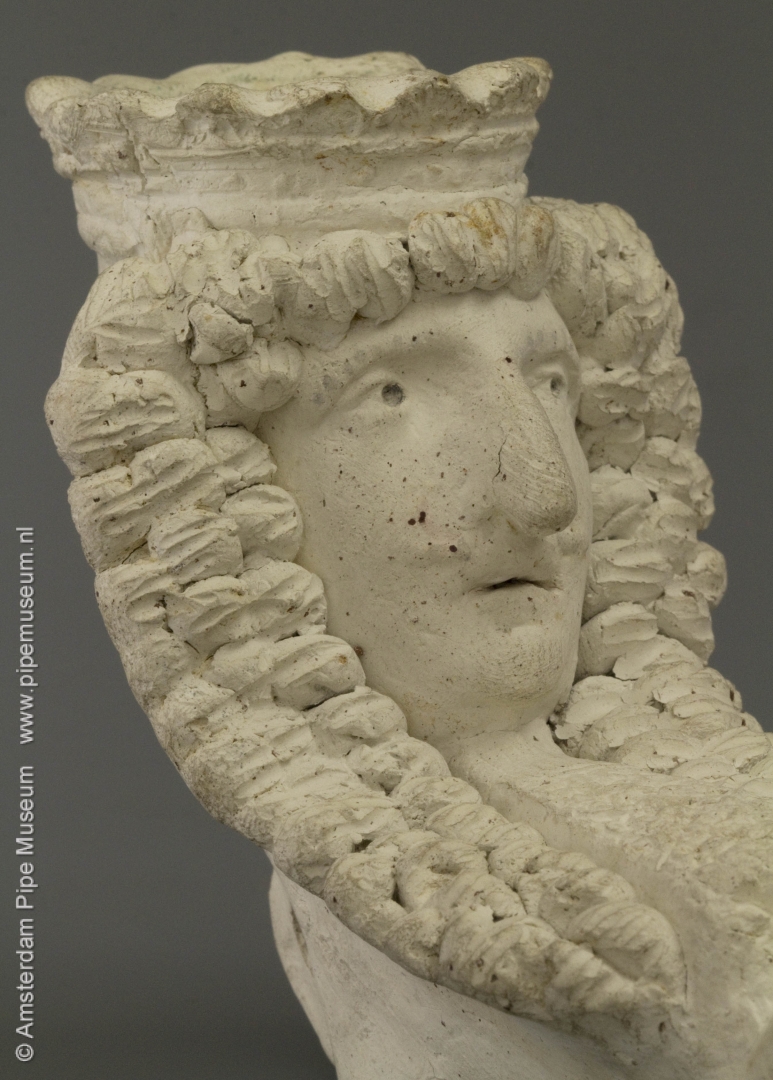
Although the tobacco pipe is in principle smokable, it still seems to be a decorative object or promotional item. The content is much too large to smoke, and no burn marks have been left in the bowl. To serve as a sign on the facade of a house the object is too small and, above all, too refined. This is different when the object hangs on the wall in a pipe shop or is placed on a shop cupboard. In the latter case, perhaps even in a series. Hanging indoors is also safest against damage.
There are two candidates for the proposed in the pipe. By far the greatest preference is given to Prince William III of Orange when he was still stadtholder and he was generally depicted with a mustache. This mustache disappeared around 1680, although the designer may of course have used an old print for inspiration. In 1689, the stadtholder is proclaimed king of England, making the crown more appropriate. That crown excludes the depiction of other important people at the time of the Republic. Naval heroes such as De Ruijter or Tromp are therefore not eligible, although these figures were also popular at the time and also wore the same type of wig.
For a moment the doubt arises whether this pipe actually represents Stadholder William III. Could it possibly be the French King Louis XIV? The Sun King also had such a fashionable mustache in his younger years. In addition, a variant of this pipe is known, which shows three lilies on the coat of arms on the stem, a direct reference to the French royal coat of arms. Louis XIV is a contemporary of William III but enjoyed little popularity in Holland. The latter makes it less likely.
It is certain that the pipe was made in Gouda. That must have been in the late 1670s at the earliest, but more likely in the 1680s or perhaps even the nineties of the seventeenth century. During that period, the Gouda pipe became more beautiful and developed into a real mass article that is diametrically opposed to this figural, more artistic product. A maker's mark was part of the competition for the serial products, but this was not important with such a special pipe. Unfortunately, since the mark is missing, the maker remains anonymous..
Amsterdam Pipe Museum APM 22.668
Tobacco pipe for the West India Company
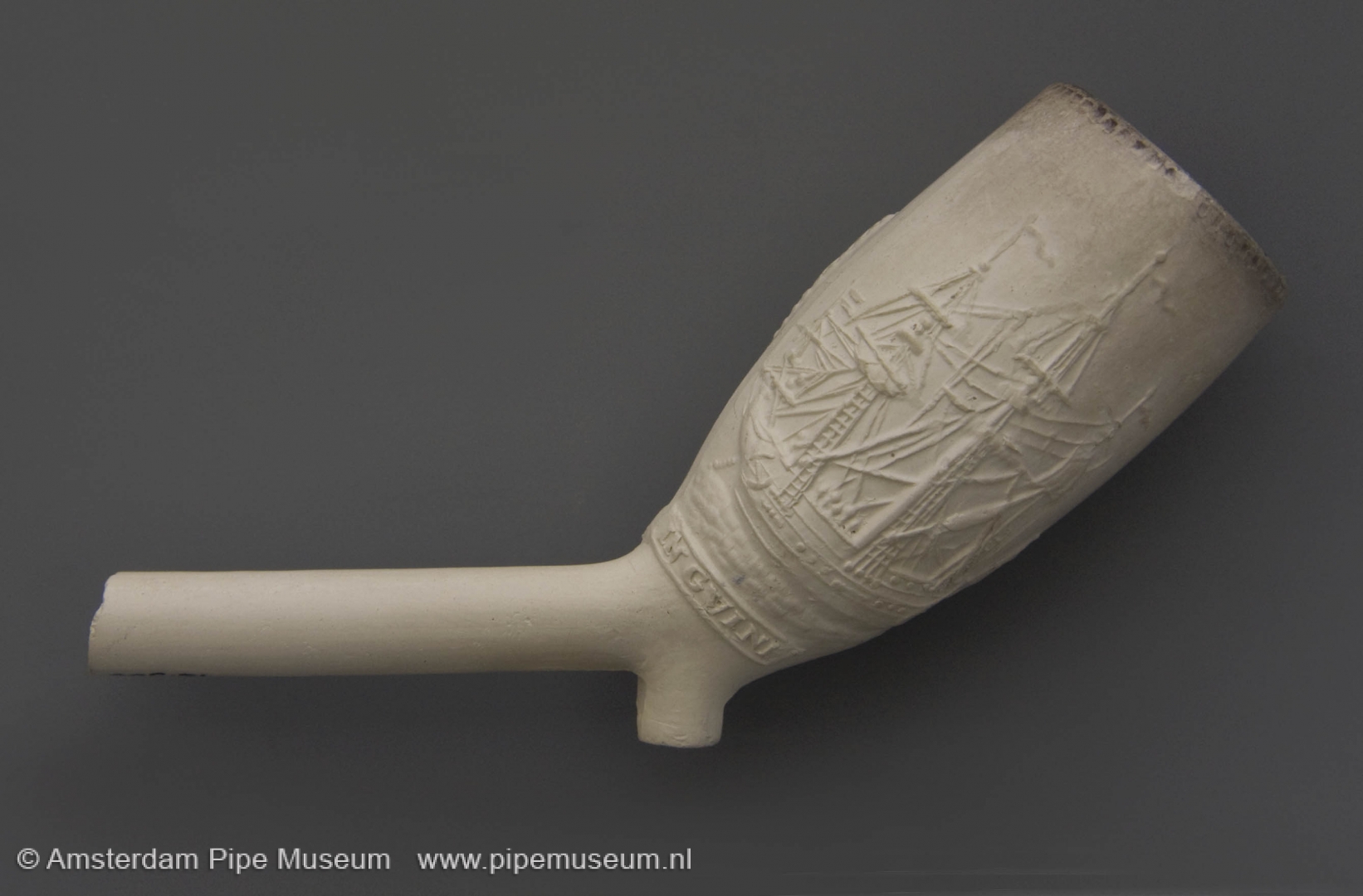
This tobacco pipe from the 1730s is exceptionally refined in design and decoration. The pipe is characteristic of its time and is a testament to the heyday of the Gouda pipe industry. Shortly after 1730, the Gouda pipe makers developed a new pipe shape with an oval bowl and a long straight stem. Initially, that oval shape was still a bit hesitant and too slim like this pipe bowl. The oval bowl will become the most popular pipe model on Dutch soil, a shape that would remain popular worldwide for more than two centuries.
The renewed design of the oval bowl also called for a more refined relief decoration for which the most skilled silversmiths from Gouda were deployed. They cut out the engraving in the mould using a burin and hammer punches. Here the engraving is dedicated to the West India Company. On the right side of the pipe bowl a transom ship or Indiaman is depicted, the largest merchant sailing vessel with three masts, which also appears in the coat of arms of the WIC. On a text ribbon at the bottom we read WELKOM IN GVINE (welcome to Guinea). The mention Guinea here refers to the countries along the Gulf of Guinea, present-day Ghana, Togo, Benin and Nigeria, the area where the WIC had a patent to trade.
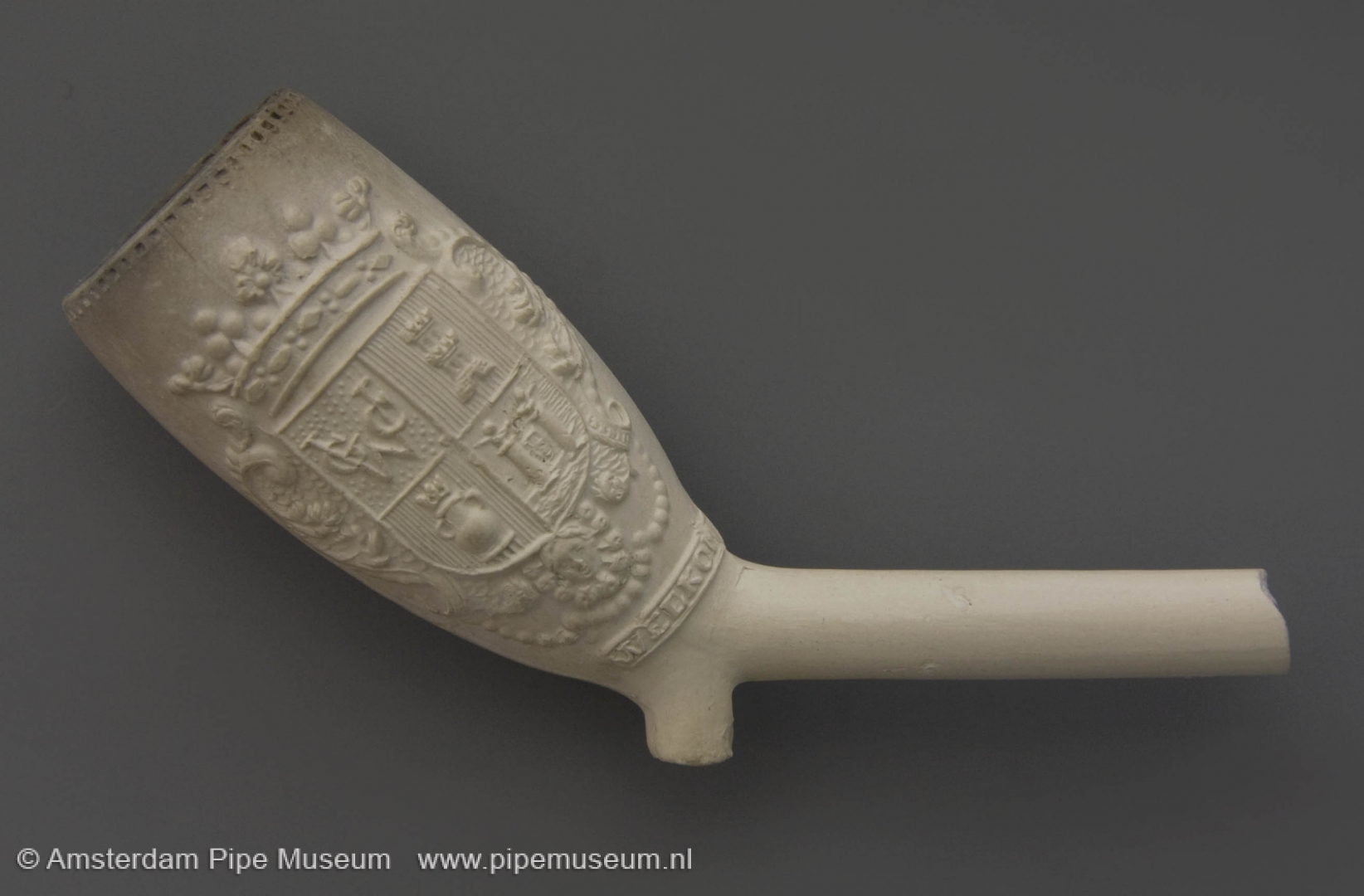
The company coat of arms is depicted on the other side of the bowl, the shield divided in four quarters. In the first we see the emblem of the trade association, the GWC monogram which stands for the Geoctroyeerde Westindische Compagnie. The other three quarters are filled with the coat of arms of Middelburg, Veere and Vlissingen, as the seats of the governing Chambers of the company. The trade association sailed to Suriname via the African west coast. Besides sugar, the slave trade was by far the most important of their activities. The release of such a special pipe does prove the importance of westward naval trade through the WIC.
The maker of this interesting pipe bowl is the Gouda manufacturer Reijnier Blom, a descendant of a Gouda pipe maker family. His factory is known as a consistent family business that had already existed for a few generations by then and more often handled export orders in pipes. When Reijnier died in 1741, his mark 46 was transferred to the pipe merchant Jacob de Vos. This mark will be used for export pipes for a long time to come.
At the time, it was customary to present one copy of such decorated pipes with a gross of ordinary smooth pipes as a gift. The article was therefore not available in quantity. The press mold of such a finely decorated pipe got worn quickly, making a large print run impossible. The fact that these are gift items explains the rarity of the pipes back then and today.
This pipe is not known from archaeologial sites in other countries, so proof whether the pipes were smoked abroad has not yet been provided. The present specimen was found in land in the Bijlmermeer near Amsterdam in 1978 and must have been smoked on Dutch soil. The anonymous smoker of that time will never be known again, so we do not know in which circles the pipe was used.
What is special is that the VOC, the Dutch East India Company, also had its own tobacco pipe, even with an almost identical design. The merchant ship appears on both pipe bowls, at the VOC version the coat of arms is supplemented with two small arms of the VOC and the city of Amsterdam. The text ribbon reads WELKOM OP BATAVIA (welcome to Batavia). In the case of the VOC, a company pipe is more logic. Trade on the east was more profitable. Moreover, prosperity in the east was significantly greater which gave rise to more demand for clay pipes. This is also proven by the luxurious pipe holder or chic storage boxes that were available for smoking equipment. Opposite to the East, the West had not such a high-quality material culture. The production of a WIC pipe is therefore all the more remarkable.
Amsterdam Pipe Museum APM 15.300
Export pipe with regal profile portrait
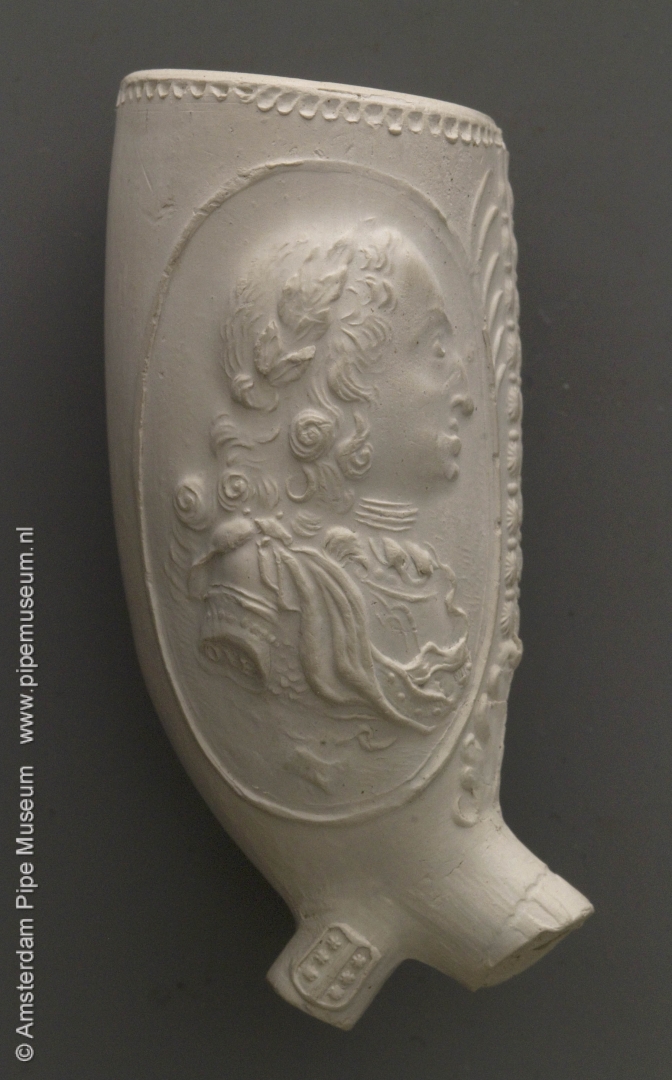
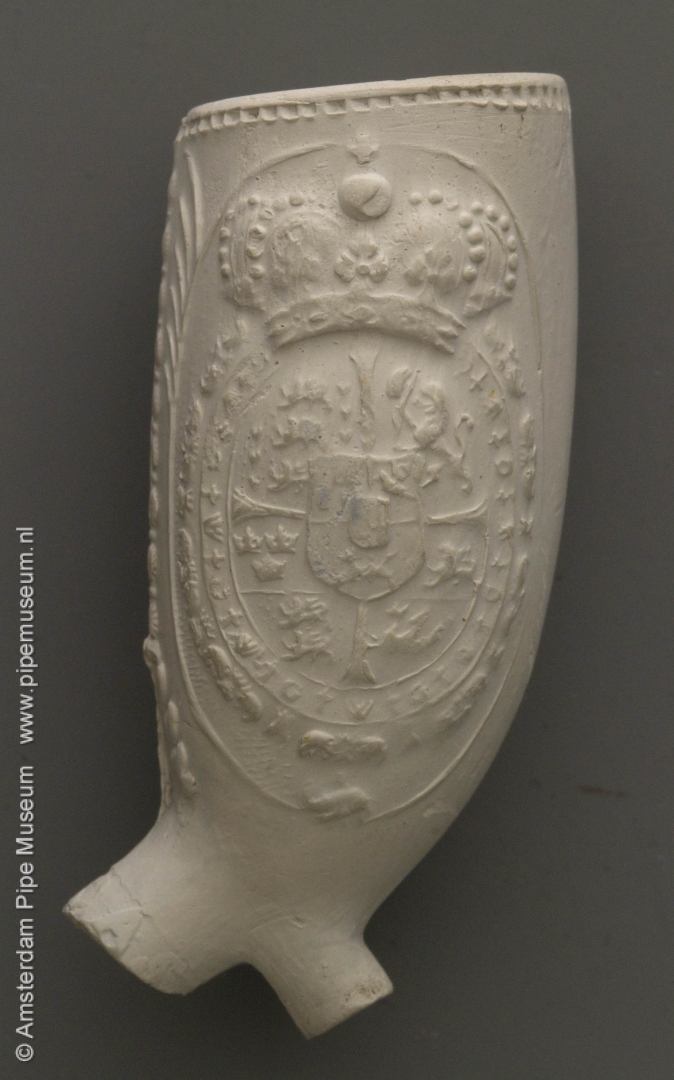
The pipe industry in Gouda was supra regional from the very beginning. The production there was larger than local demand and it is therefore not surprising that sales were sought outside the province. Over time, these sales were found further and further away, which led to real exports. It soon became customary to produce special pipe shapes for a specific customer group. For instance the so-called kromkop pipe bowl depicted here, not the standard Dutch oval bowl, but a pipe with asymmetrical outline. The pipe bowl has a specific shape intended for a target group elsewhere. Anyone familiar with the development of the clay pipe will immediately see that this shape was developed under the influence of the English tobacco pipe. The execution, however, was done in the Dutch way and that is especially evident in the finish. Most characteristic is the appearance of a milling around the bowl opening, a typical Gouda finish that was not in use in England at the time. This makes this pipe bowl an object mainly intended for areas where the English clay pipe was previously sold.
The decoration is typically Gouda and was done by the best pipe mould engraver, namely Dillis van Oye, whose work has never been surpassed in delicacy. In this quite exceptional case, he engraved his initials DVO on the sleeve of the depicted person. It is quite certain who is depicted. It cannot be anyone else than Christian VI, king of Denmark from 1730 to 1741. We must almost conclude that Van Oye had the coronation medal of this king at his disposal in Gouda, or at least an image of it. The resemblance is too coincidental: the long wig was a common fashion feature throughout Europe at the time, but Christiaan is the only Danish monarch to be depicted with a laurel wreath in the wig. Additionally, the hooked nose makes the man well recognizable. The medalist has put his signature in the arm cut, a not very conspicuous, very suitable place. Van Oye thought that was such a clever find and exchanged it on the pipe for his own signature.
The elaborate coat of arms on the reverse of the pipe bowl matches the portrait bowl perfectly. We see the Great Royal Coat of Arms of Denmark in use from 1699 to 1819, so also at the time of Christian VI. The coat of arms is so complicated because countless areas are represented in it: Denmark, Sweden, Norway, Schleswig and Holstein, Bremen and Oldenburg. The coat of arms is surrounded by the collars of the Order of the Dannebrog and around it the even higher Order of the Elephant.
What makes this pipe interesting is that it concerns an English pipe shape, intended for export to an area where the Gouda pipe wanted to compete with the English import. Apparently this was the case in Northern Germany and Scandinavia. While the pipe model follows the desired English fashion, the decoration is pure Gouda. The engraving, which elsewhere is almost exclusively reserved for medalists and mint masters, is used in pipe moulds in Gouda. This makes high-quality engraving art accessible to the pipe smoker. In this case not for everyone, because one of these highly decorated pipes was a bonus with the purchase of a gross smooth pipes. It can be expected that the customers in Denmark were pleasantly surprised when they found a pipe with their own king in the box - and of course ordered it again in Gouda next time. The Gouda pipe industry had thus created a unique selling point!
The snake mark is imprinted on the heel, owned by Lucas Evertse de Jong, an authoritative pipe maker who was a member of the Gouda guild board for many years. His company fulfilled orders to all corners of the world. In addition to the maker's mark, we also see the Gouda coat of arms on the side of the heel. This guaranteed origin from Gouda, a privilege that Gouda had to protect against counterfeiting. This mark was granted in 1739 and 1740 and therefore we know that the pipe bowl was made after that year. The Danish monarch, who died in 1741, was probably already dead by then.
Amsterdam Pipe Museum APM 903